Single-dose, virus-vectored vaccine protection against Yersinia pestis challenge: CD4+ cells are required at the time of challenge for optimal protection
- PMID: 18832004
- PMCID: PMC2628553
- DOI: 10.1016/j.vaccine.2008.09.031
Single-dose, virus-vectored vaccine protection against Yersinia pestis challenge: CD4+ cells are required at the time of challenge for optimal protection
Abstract
We have developed an experimental recombinant vesicular stomatitis virus (VSV) vectored plague vaccine expressing a secreted form of Yersinia pestis low calcium response protein V (LcrV) from the first position of the VSV genome. This vector, given intramuscularly in a single dose, induced high-level antibody titers to LcrV and gave 90-100% protection against pneumonic plague challenge in mice. This single-dose protection was significantly better than that generated by VSV expressing the non-secreted LcrV protein. Increased protection correlated with increased anti-LcrV antibody and a bias toward IgG2a and away from IgG1 isotypes. We also found that the depletion of CD4+ cells, but not CD8+ cells, at the time of challenge resulted in reduced vaccine protection, indicating a role for cellular immunity in protection.
Figures
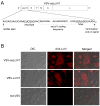
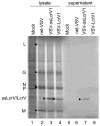

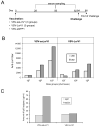
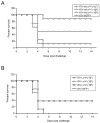

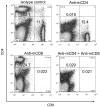
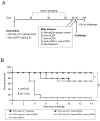
Similar articles
-
A Recombinant Attenuated Yersinia pseudotuberculosis Vaccine Delivering a Y. pestis YopENt138-LcrV Fusion Elicits Broad Protection against Plague and Yersiniosis in Mice.Infect Immun. 2019 Sep 19;87(10):e00296-19. doi: 10.1128/IAI.00296-19. Print 2019 Oct. Infect Immun. 2019. PMID: 31331960 Free PMC article.
-
rLVS ΔcapB/Yp F1-V single vector platform vaccine expressing Yersinia pestis F1 and LcrV antigens provides complete protection against lethal respiratory challenge with virulent plague bacilli.Hum Vaccin Immunother. 2025 Dec;21(1):2507475. doi: 10.1080/21645515.2025.2507475. Epub 2025 May 26. Hum Vaccin Immunother. 2025. PMID: 40417828 Free PMC article.
-
Intranasal delivery of a protein subunit vaccine using a Tobacco Mosaic Virus platform protects against pneumonic plague.Vaccine. 2016 Nov 11;34(47):5768-5776. doi: 10.1016/j.vaccine.2016.09.063. Epub 2016 Oct 13. Vaccine. 2016. PMID: 27745954 Free PMC article.
-
Protecting against plague: towards a next-generation vaccine.Clin Exp Immunol. 2013 Apr;172(1):1-8. doi: 10.1111/cei.12044. Clin Exp Immunol. 2013. PMID: 23480179 Free PMC article. Review.
-
Plague vaccines and the molecular basis of immunity against Yersinia pestis.Hum Vaccin. 2009 Dec;5(12):817-23. doi: 10.4161/hv.9866. Epub 2009 Dec 1. Hum Vaccin. 2009. PMID: 19786842 Review.
Cited by
-
Complementing defective viruses that express separate paramyxovirus glycoproteins provide a new vaccine vector approach.J Virol. 2011 Mar;85(5):2004-11. doi: 10.1128/JVI.01852-10. Epub 2010 Dec 22. J Virol. 2011. PMID: 21177820 Free PMC article.
-
Plague Vaccines: Status and Future.Adv Exp Med Biol. 2016;918:313-360. doi: 10.1007/978-94-024-0890-4_12. Adv Exp Med Biol. 2016. PMID: 27722869 Free PMC article. Review.
-
Multi-Functional Characteristics of the Pseudomonas aeruginosa Type III Needle-Tip Protein, PcrV; Comparison to Orthologs in other Gram-negative Bacteria.Front Microbiol. 2011 Jul 4;2:142. doi: 10.3389/fmicb.2011.00142. eCollection 2011. Front Microbiol. 2011. PMID: 21772833 Free PMC article.
-
A chimeric vesiculo/alphavirus is an effective alphavirus vaccine.J Virol. 2013 Jan;87(1):395-402. doi: 10.1128/JVI.01860-12. Epub 2012 Oct 17. J Virol. 2013. PMID: 23077320 Free PMC article.
-
Intranasal prophylaxis with CpG oligodeoxynucleotide can protect against Yersinia pestis infection.Infect Immun. 2013 Jun;81(6):2123-32. doi: 10.1128/IAI.00316-13. Epub 2013 Apr 1. Infect Immun. 2013. PMID: 23545300 Free PMC article.
References
-
- Galimand M, Guiyoule A, Gerbaud G, Rasoamanana B, Chanteau S, Carniel E, et al. Multidrug resistance in Yersinia pestis mediated by a transferable plasmid. N Engl J Med. 1997;337(10):677–80. - PubMed
-
- Hinnebusch BJ, Rosso ML, Schwan TG, Carniel E. High-frequency conjugative transfer of antibiotic resistance genes to Yersinia pestis in the flea midgut. Mol Microbiol. 2002;46(2):349–54. - PubMed
-
- Inglesby TV, Dennis DT, Henderson DA, Bartlett JG, Ascher MS, Eitzen E, et al. Plague as a biological weapon: medical and public health management. Working Group on Civilian Biodefense Jama. 2000;283(17):2281–90. - PubMed
Publication types
MeSH terms
Substances
Grants and funding
LinkOut - more resources
Full Text Sources
Medical
Research Materials

